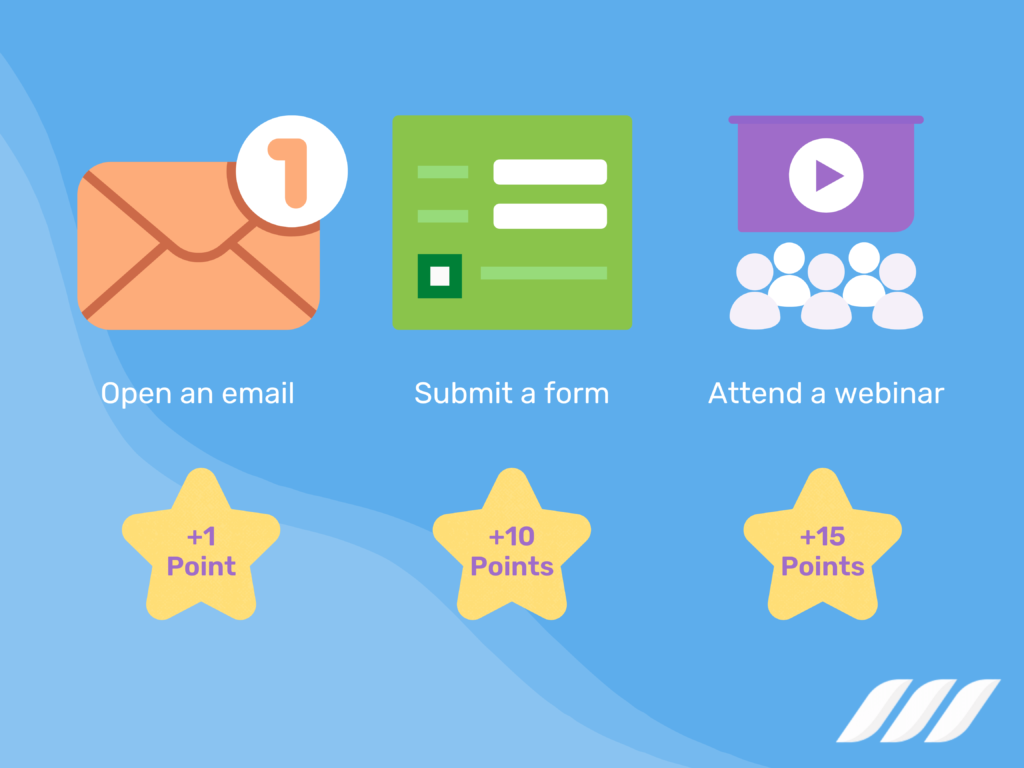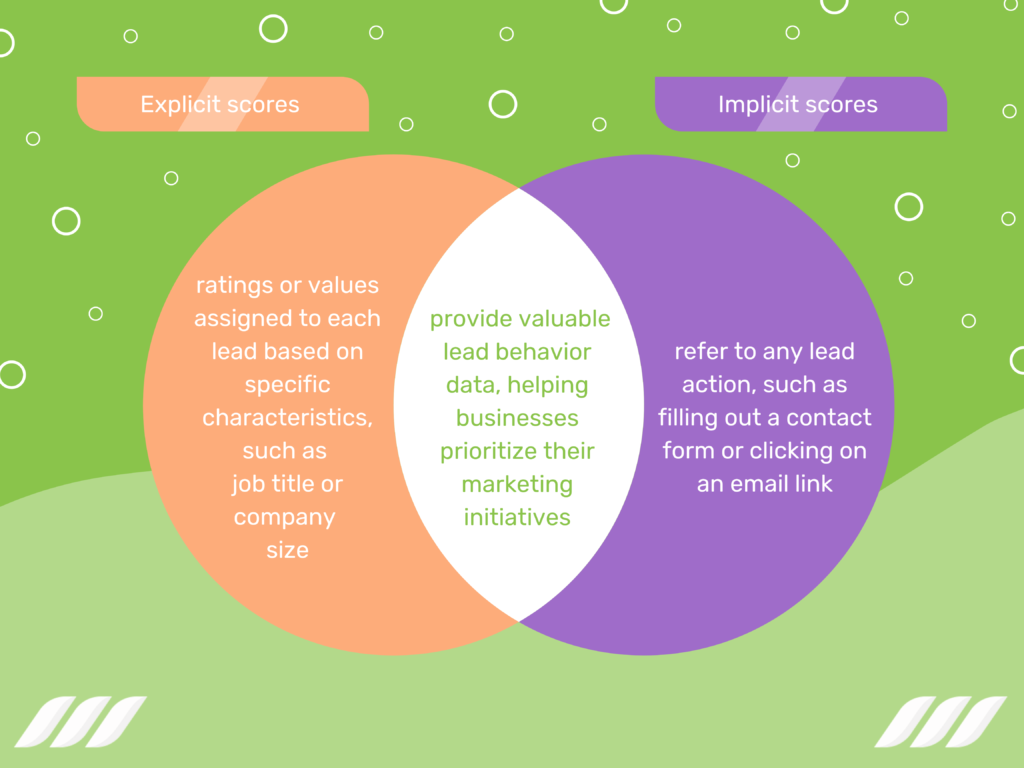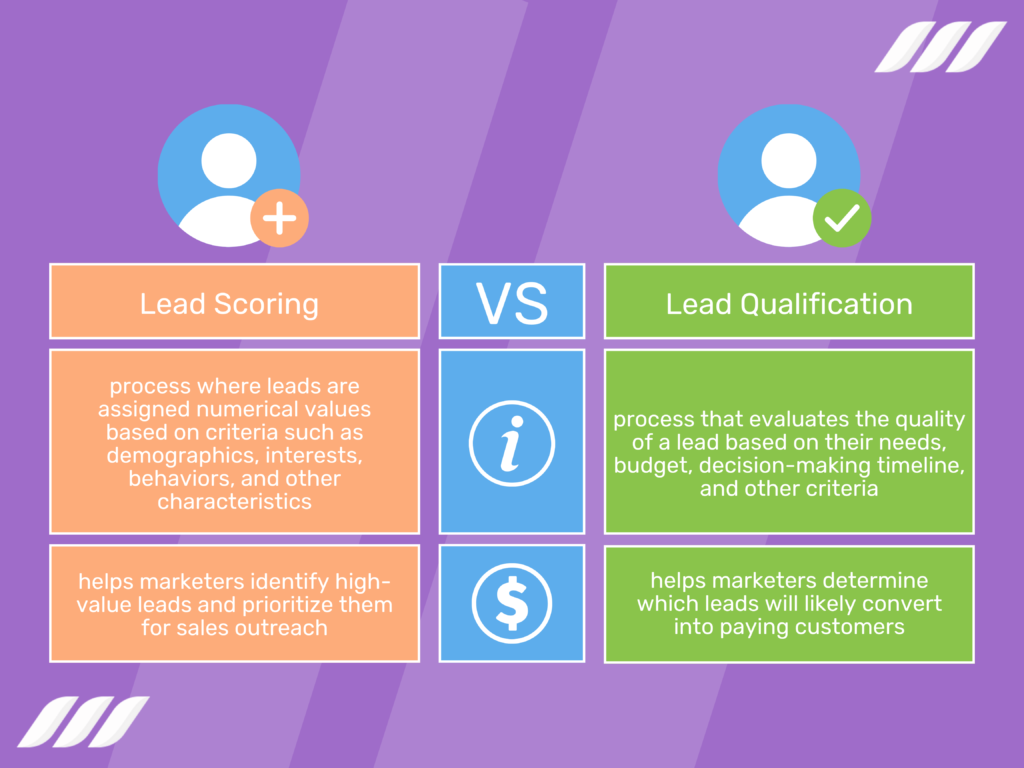|
Getting your Trinity Audio player ready...
|
In the world of B2B marketing, inbound and outbound leads compete for attention. This makes lead scoring so important. Lead scoring helps you select the best leads for your sales team to follow up on. It allows you to prioritize leads and focus on those most likely to become customers.
The process of assigning points to each lead based on specific criteria, such as demographics and past interactions, helps you organize leads into a hierarchy. This ensures that more qualified leads or those who have taken certain actions on your website are given priority over others.
This guide will walk you through everything you want to know about B2B lead scoring, from the basics to more advanced techniques and tips to get started.
Read also: Lead Source: Where Does a Client Come From?
What Is Lead Scoring?
Lead scoring is an important methodology used by businesses and sales teams to measure and quantify the value of a potential customer or lead. It involves assigning numerical values to leads based on certain criteria, such as demographics, interests, and online behavior.
B2B lead scoring helps sales teams identify high-value prospects most likely to become paying customers. It’s useful because it allows businesses to prioritize their sales efforts and allocate resources more efficiently.
Why Is Lead Scoring Important?
Lead scoring also helps identify which leads require more nurturing or outreach, enabling sales teams to optimize their outreach strategies and increase conversions.
B2B lead scoring is an effective way for businesses to accurately measure the value of potential customers or leads and prioritize their sales efforts accordingly.
It enables sales teams to identify high-value prospects and allocate resources more efficiently, thereby reducing the cost of customer acquisition.
Lead scoring can also help sales teams optimize their outreach strategies and increase conversions, leading to higher revenues. With lead scoring, businesses can maximize their ROI and achieve better results quickly.
Read also: Why You Need Dripify for Sales Teams

Top 6 Lead Scoring Models
Businesses need to have a lead-scoring model in place to generate more leads and conversions. But with so many different metrics and models, knowing which is right for your business can be challenging.
Lead scoring models provide valuable insights by allowing B2B companies to determine which leads should receive higher priority and analysis.
Read also: Lead Generation Marketing Trends
Let’s look at six popular lead-scoring models that you may want to incorporate in your lead generation strategy:
1. Company or Brand Profile
A company’s profile is essential for understanding how it may fit in a B2B company’s lead scoring model. It contains useful company information such as its type, size, industry, company specialties, and contact details.
This allows B2B companies to build a better picture of the company and create an effective lead-scoring model that reflects their particular target market. Without this data, assessing whether they meet the company’s criteria would be impossible. A company profile helps define more effective lead-scoring models for businesses across all industries.
Read also: B2B Sales Strategies to Grow Your Business
2. Demographics
A demographic-based lead scoring is an effective way for businesses to prioritize their target audience and optimize the customer experience. High-scoring leads are those whose demographics are most closely connected to your product or services.
That’s why they are more likely to convert. With defined demographic information, companies can prioritize which leads their audience to have the highest probability of success and focus on them first.
A focused approach to customer acquisition can maximize resources and ensure that high-quality leads receive attention.
3. Lead’s Behavior


Use online behavior to determine the quality of a lead when crafting lead-scoring models. Consider how a lead interacts with online platforms, such as website visits, engaging with content, and viewing online ads. It helps build an overall profile for each lead that can be used to determine their value.
It’s important to understand your customer’s behavior so that you create more effective campaigns and know when marketing efforts are wasted on leads unlikely to convert. With the right strategy, using a lead scoring model helps maximize your ROI.
4. Engagement Through Email
Email marketing is a key part of an effective lead-scoring model. It’s one of the best ways to engage prospects and build relationships with them, as email allows companies to provide customized and tailored content that directly speaks to their interests.
Companies can use email campaigns to score leads based on email engagement, such as opens and clicks. This ensures they have detailed insight into which email messages resonate with their target audience. Through this intuitive system, businesses can then adjust their email content strategy.
5. Engagement on Social Media
Leveraging interactions on social media is becoming an increasingly popular technique for lead qualification. A well-thought-out lead scoring model can better identify high-value prospects and determine the best contact strategy.
For example, interactions such as ‘likes,’ ‘shares,’ and ‘comments’ can be set to higher point levels than interactions like viewing content. Additionally, these points can accumulate over time to build more in-depth customer profiles. Engagement on social media helps score a lead effectively.
6. Spam Detection for Inaccurate Lead Scoring Data
Accurate and significant contact information is the starting point of many campaigns. However, in some cases, the lead scoring data can present inaccurate or insignificant information. That’s why businesses must consider all the contact information provided.
This lead scoring template would assign points to each data set to help you better score potential leads. Not only will this help ensure accuracy and relevance in your data, but it can also provide you with improved marketing insights about your customers.


How to Create a Successful Lead Scoring
Lead scoring allows you to rate leads according to their likelihood of converting into customers. This helps you focus your efforts on the most promising leads, saving you time and energy while increasing your chances of making a sale.
But what goes into lead scoring? Let’s explore how you can create a system that works for your business.
1. Identify Your Audience
A successful lead-scoring process is key to nurturing leads and increasing customer interest and potential sales. For such a process to be successful, it’s important to identify your audience broadly.
Define the broad characteristics of your target customers and focus on their needs, wants, and interests. Additionally, you can use the data from your broader audience to profile the type of leads you want to prioritize.
2. Define Your Ideal Customer
Identifying and understanding our ideal customer is essential for any business. Doing this requires detailed lead-scoring processes that track key data points such as demographics, income level, job title, and buying behavior.
Once this lead scoring process has been completed and lead data has been collected, segmenting the leads becomes a much simpler task. And then, you can determine which leads are likely to be the most impactful.
3. Set Up Your Scores


Establish a point system where each lead is awarded points for specific actions.
For example, opening an email might award +1 points, submitting a form on your landing page may get +5 points, and attending a webinar could be worth as much as +10 or +15 points.
As customers take further steps that show their interest in your offerings, they get more points, which gives you an idea of how likely they can be a customer. By setting up these scores based on customer engagement, B2B lead scoring can help increase conversion rates.
4. Analyze, Improve, and Repeat
Lead scoring actions should be monitored and tweaked regularly based on data results. If the lead scoring process is not yielding the desired results, it’s important to analyze where improvements can be made.
Tracking customer activity over time lets you make more informed decisions about their conversion likelihood. Businesses can ensure their efforts yield the highest return by regularly monitoring and improving lead-scoring processes.
How to Calculate a Basic Lead Score
There are three methods used to calculate a basic lead score:
- Logistic Regression Lead Scoring
- Predictive Lead Scoring
- Manual Lead Scoring
Let us dive into each one of them to understand how they work:
Logistic Regression Lead Scoring
This type of lead scoring uses a complex mathematical model based on logistic regression, which is used to predict the probability that a lead will convert. The model considers multiple factors, such as demographic information and previous interactions with your company, to create an overall lead score.
The higher the lead score, the more likely it is that the lead will convert into a sale. This type of scoring can be helpful when dealing with large volumes of leads, as it helps quickly identify those who are more likely to buy from you.
Predictive Lead Scoring


Predictive lead scoring is similar to logistic regression but considers multiple factors to create a more accurate prediction. These factors include web browsing behavior, email engagement, and social media interactions.
The predictive model uses machine learning algorithms to analyze this data to determine which leads are most likely to convert.
Manual Lead Scoring
Manual lead scoring is a more manual process of assigning scores to leads. It involves manually creating rules and assigning scores to each lead based on those rules.
This can be helpful for smaller businesses, as it allows for customization and control over the lead-scoring process.
That’s how you calculate a basic score manually:
- Calculate the lead-to-customer conversion rate.
- Choose attributes of high-quality leads.
- And finally, calculate the individual close rate of each action.
No matter which type of lead scoring you choose, monitoring your lead scores regularly and adjusting them as needed is important.




Is One Lead Score Enough?
Generally speaking, one lead score may not accurately capture your customer base’s nuances. Multiple lead scores can help you identify and segment leads more effectively by considering factors such as geography, interests, and more.
Different scoring systems for different contact groups help you better focus your sales and marketing efforts on the highest potential for success.
For instance, if you’re trying to target a certain region or industry, having separate scores will allow you to identify those contacts that match this criterion.
You can then direct your campaigns accordingly and tailor them to specific personas or profiles to increase engagement and conversions.
Having multiple lead scores also makes it easier to customize your qualification process.
7 Tips to Run Lead Scoring Effectively
From setting realistic criteria to running regular reports, the tips below will help you fine-tune your process and maximize your leads’ potential.
1. Get to Know Explicit and Implicit Scoring


While lead scoring may seem intimidating initially, it’s straightforward to understand. Businesses can track potential lead engagement and progress through the sales funnel by separating lead scores into explicit and implicit ones.
Explicit scores are ratings or values assigned to each lead based on specific characteristics, such as job title or company size. Meanwhile, implicit scores refer to any lead action, such as filling out a contact form or clicking on an email link.
Both scoring types provide valuable lead behavior data, helping businesses prioritize their marketing initiatives.
2. Define Your Lead Scoring Thresholds
Cold leads, hot leads, and prospects make up the bulk of any sales funnel, but it’s far too easy to waste time on leads that never convert. Defined thresholds can help you quickly identify different leads that should be prioritized over those that may never convert.
3. Align Your Marketing With Sales
Organizations can better understand opportunities by connecting sales and marketing departments, reallocating resources, and optimizing targeting strategies. They can also understand the actual return on their marketing investments.
4. Assign Positive Lead Scores for Customer Actions
After setting up lead thresholds and aligning marketing and sales teams, assigning positive lead scores for customer actions is important. This helps recognize prospects’ valuable interactions with your organization, from website visits to product demos.
These are some of the lead-scoring actions:
- Regular visits to a website over time.
- Downloads or event registrations.
- Form completions.
- Email opens, clicks, and forwards.
- Demos and trials of products or services.
- Visits to a pricing page.
- Blog views and CTA clicks.
Assigning a higher score for certain customer actions can help identify high-value prospects quickly and allow sales teams to focus their time on them.
Read also: How to Motivate Your Sales Team
5. Score Your Leads Who Fit Your Buyer Persona
Buyer personas are a key component of any lead-scoring strategy, as they help define target audiences. When crafting lead scoring models, it’s important to include characteristics that match your buyer personas.
6. Monitor Your Lead Scores Over Time
Lead scores are constantly changing, so monitoring them regularly is important. As prospects interact with your marketing efforts, their lead score will shift, sometimes dramatically. That’s why tracking lead scores over time and adjusting your lead scoring template is important.
7. Use the Right Lead Scoring Tools
Lead scoring is a complex process, and having the best sales automation tools can make it much easier. Using the right lead-scoring software or platform can create more accurate lead templates with minimal effort.
These platforms typically have detailed reporting and analytics capabilities that help you track progress and adjust your strategy. They also provide automation capabilities that make it easier to score leads quickly and accurately.
You can create a successful sales process that delivers results with the right combination of lead-scoring strategies and tools. For example, Dripify sales automation software helps you maximize conversion rates and optimize ROI using the power of automation.




Lead Scoring vs. Lead Qualification
Lead scoring and lead qualification are two important methods used by marketing and sales teams to determine the quality of leads.
Lead scoring is a process where leads are assigned numerical values based on criteria such as demographics, interests, behaviors, and other characteristics. This score helps marketers identify high-value leads and prioritize them for sales outreach.


Lead qualification is a process that evaluates the quality of a lead based on their needs, budget, decision-making timeline, and other criteria. This process helps marketers determine which leads will likely convert into paying customers.
Both methods are closely related and provide valuable insights into customer profiles.
Lead scoring can help identify high-value leads that qualify for sales outreach, while lead qualification is a more detailed process that can help uncover the true value of each lead.
When used together, lead scoring and lead qualification can offer powerful insights into customer profiles, allowing marketers to target their marketing efforts more effectively.
Conclusion
In lead scoring, leads are assigned numerical values based on criteria such as demographics, interests, behaviors, and other characteristics. This score helps marketers identify high-value leads and prioritize them for sales outreach.
Lead scoring strategies should also include buyer personas which help define target audiences and identify prospects who fit the mold of an ideal customer.
Businesses can calculate a basic lead score with predictive, logistic regression, or manual lead scoring. All you need is to determine the criteria for scoring leads, assign a weight to each criterion, and use lead scoring tools or platforms to track lead scores.

![How to Write a Price Increase Letter [Tips, Examples, and Free Template]](https://dripify.io/wp-content/uploads/2021/12/27.png)
![How to Write an Effective Collaboration Email [+Templates]](https://dripify.io/wp-content/uploads/2023/05/13.png)



